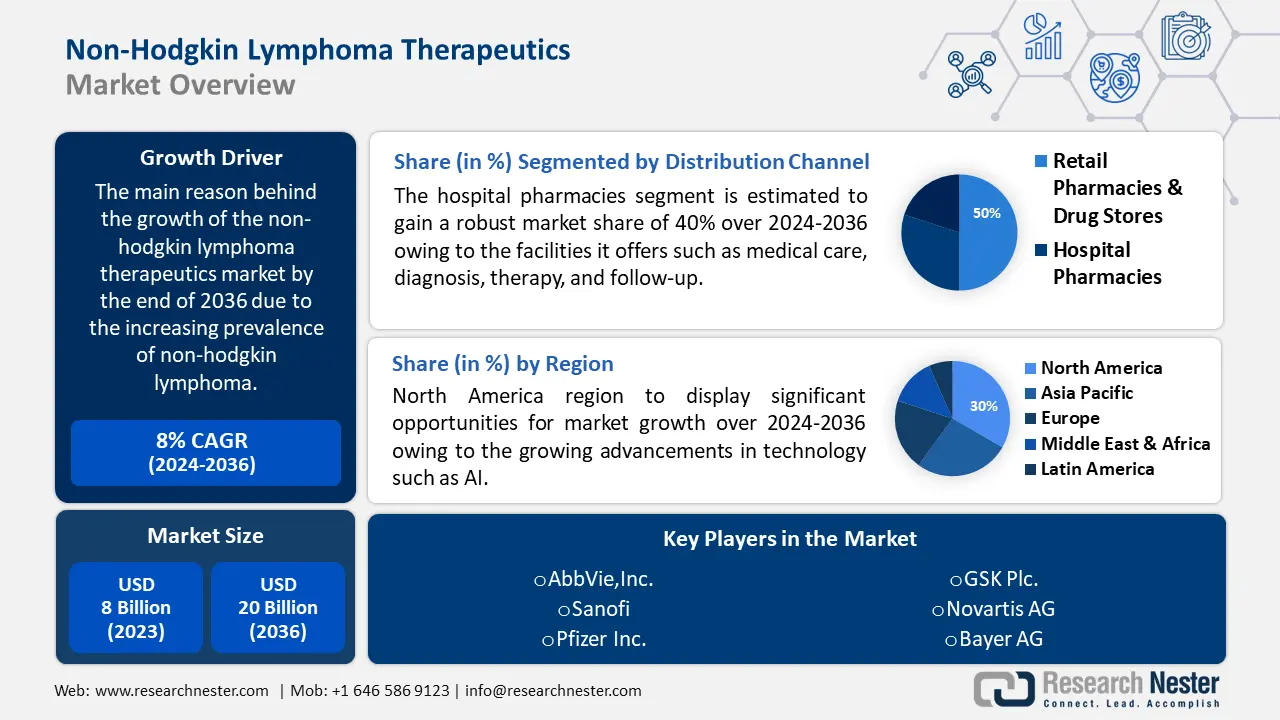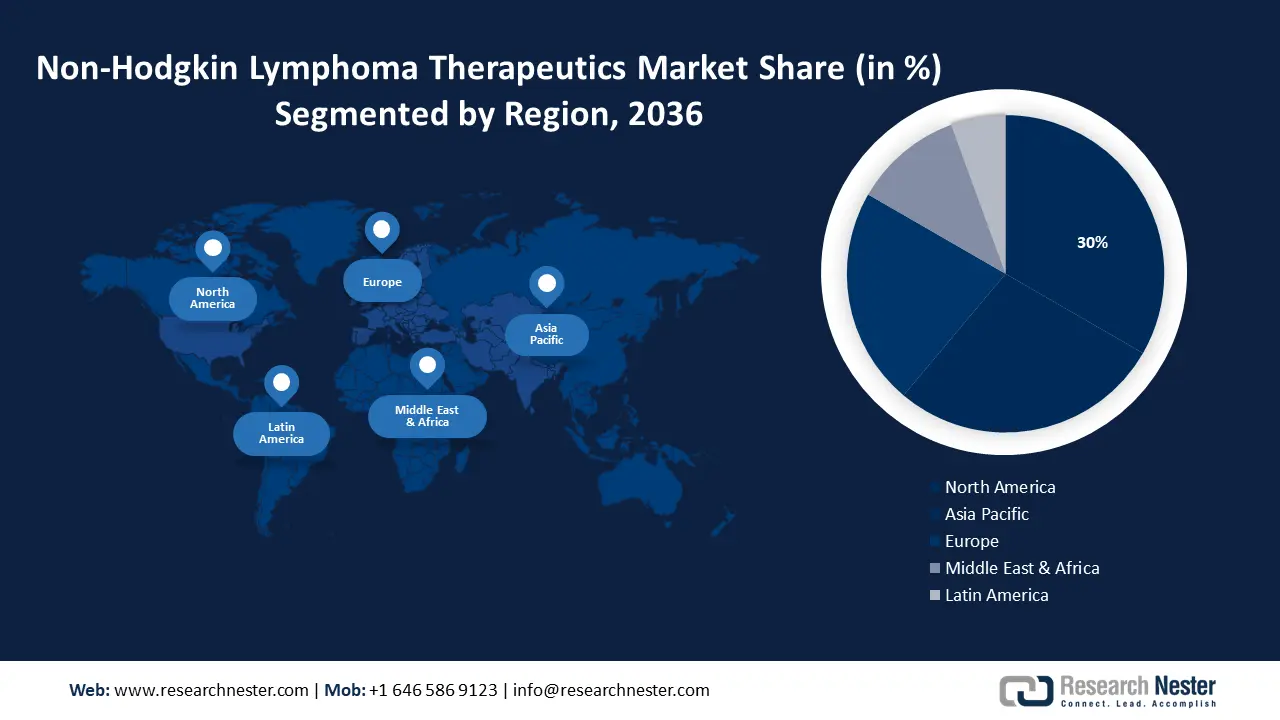
Non-Hodgkin Lymphoma Therapeutics Market size is poised to cross USD 20 billion by the end of 2036, growing at a CAGR of over 8% during the forecast period, i.e., 2024-2036. In the year 2023, the industry size of non-Hodgkin lymphoma therapeutics was close to USD 8 billion. The market’s growth is attributed to the increasing prevalence of non-hodgkin lymphoma. During the past few years, the world has witnessed a significant surge in the non-hodgkin lymphoma.
As per our survey, non-hodgkin lymphoma is amongst the most common hematological malignancy across the globe and accounts for about 3% of cancer deaths and diagnoses. Further, according to the American Cancer Society, there will be roughly 80,620 NHL diagnoses in 2024 (44,590 men and 36,030 women). This applies to both kids and adults.
Furthermore, there has been surge in research in this field in order to deal with the growing cases. For instance, Researchers funded by the NCI are improving our knowledge of lymphoma treatment. The lymph system, that's a component of the body's immune system, is the place where all lymphomas begin. Scientists are now able to create more individualized treatments for different subtypes of lymphoma owing to advances in understanding the gene alterations that might cause the disease. All this is leading to non-Hodgkin lymphoma therapeutics market growth.

Growth Drivers
Adults with NHL who are older may find treatment difficult. A decrease in functional reserve that is unique to each person as they age raises the possibility of treatment-related toxicity and death. Furthermore, the primary determinant of a patient's survival following a cancer diagnosis is their age. As a result, the demand for non-Hodgkin Lymphoma market is rising.
The high number of patients with these tumors, who frequently need intensive and precise therapy because their symptoms don't show up, is the reason for the rising demand. Despite advanced diagnostics, the diagnosis of cancer in its latter stages is frequently made due to the absence of symptoms. Throughout the forecast period, this is anticipated to further fuel the market expansion for non-hodgkin lymphoma therapeutics. Therefore, the demand for more sophisticated treatments has resulted in rising R&D trends in the market.
Challenges
However, with developing and poor economies, there are few therapeutic choices available for the treatment of diseases. Although non-hodgkin lymphoma and other blood malignancies are highly prevalent in these nations, patients find it challenging to receive treatment on time due to a lack of available therapeutic alternatives.
This drastically limits the number of patients receiving complex and advanced care, and a sizable fraction of lymphoma patients are not receiving any treatment at all. Patients frequently cannot take advantage of these cutting-edge treatment choices, which frequently lead to superior clinical outcomes, because of inadequate payment plans and special considerations from the local governments.
|
Base Year |
2023 |
|
Forecast Year |
2024-2036 |
|
CAGR |
8% |
|
Base Year Market Size (2023) |
USD 8 Billion |
|
Forecast Year Market Size (2036) |
USD 20 Billion |
|
Regional Scope |
|
Type of Therapy (Chemotherapy, Radiation Therapy, Target Therapy)
The chemotherapy segment in the non-Hodgkin lymphoma therapeutics market is estimated to gain the largest revenue share of about 50% in the year 2036. Chemotherapy is a highly effective treatment for cancer since it stops the cancer cells from spreading more and increasingly widely. It is the most used cancer treatment, working to stop the growth of tumors and eliminate cancer cells. Furthermore, chemotherapy continues to be a mainstay since it works for a wide range of NHL subtypes, despite the advent of new therapies.
The fact that healthcare practitioners are familiar with it and its well-established protocols add to its ongoing demand. Furthermore, chemotherapy is frequently a financially advantageous course of treatment in areas with limited resources. In light of these aspects non-hodgkin lymphoma market is predicted to expand in this segment.
Distribution Channel (Retail Pharmacies & Drug Stores, Hospital Pharmacies, Online Pharmacies)
The hospital pharmacies segment is expected to hold 50% share of the global non-Hodgkin lymphoma therapeutics market by 2036. The non-hodgkin lymphoma therapies market is dominated by the hospital pharmacy segment for a number of reasons. Major cancer treatment facilities include hospitals, which offer complete care, including diagnosis, therapy, and follow-up.
The efficient distribution and administration of several medicines are made possible by this focused strategy. Hospitals are also equipped with the facilities needed to handle and store specialized treatments like targeted therapies and chemotherapy. Further, owing to rising number of hospitals the non-hodgkin lymphoma therapeutics market will flourish. The overall number of hospitals globally as of 2021 is estimated to be over 164,000.
Our in-depth analysis of the global non-Hodgkin lymphoma therapeutics market includes the following segments:
|
Type of Therapy |
|
|
Cell Type |
|
|
Distribution Channel |
|
North American Market Statistics
Non-hodgkin lymphoma therapeutics market in the North America, amongst the market in all the other regions, is anticipated to hold the largest with a share of about 30% by the end of 2036. This growth is set to be dominated by growing advancement and adoption of latest technology such as AI. For instance, in the areas of radiology, neurology, and pathology, the Food & Drug Administration (FDA) in the United States will have assessed and authorized over 500 medical AI devices by 2023.
Artificial intelligence (AI) has become so popular in the last few years that a lot of money has been spent on its development and commercialization in the medical industry. Furthermore, there has been launch of various well-regulated framework which has influenced the launch of various treatment options in the region. Also, since the healthcare sector is one of the most regulated in the US, healthcare compliance is an important and rapidly expanding field within the sector. Hence, all these factors are set to dominate the non-hodgkin lymphoma therapeutics market expansion in this region.
APAC Market Analysis
The Asia Pacific non-Hodgkin lymphoma therapeutics market is also estimated to rise over the coming years. The major element to encourage the growth of the market in this region is rising demand for generic manufacturers. Furthermore, generic drugs are considered to be most affordable.
Hence, with the availability of low-income group the market demand for generic drug is more in this region. Further, the quality of these drugs is same of that branded drugs which is why the demand for it is high. As a result, the rising need for generic drug the market for non-hodgkin lymphoma therapeutics is also set to rise in this region.



Author Credits: Radhika Gupta, Shivam Bhutani
Copyright © 2024 Research Nester. All Rights Reserved

FREE Sample Copy includes market overview, growth trends, statistical charts & tables, forecast estimates, and much more.
Have questions before ordering this report?